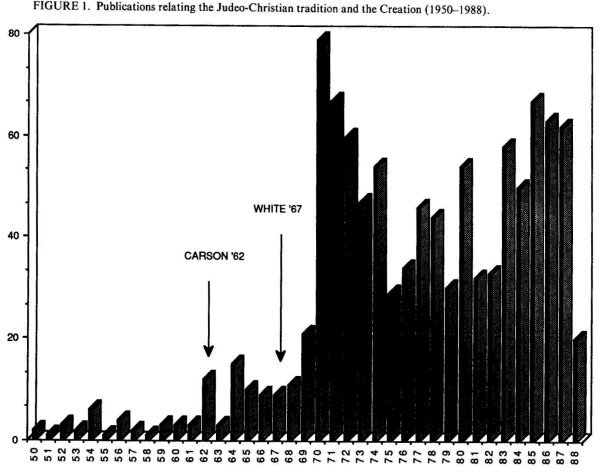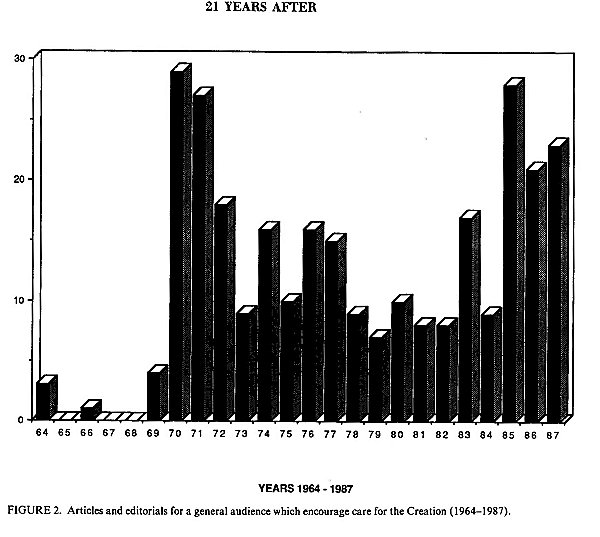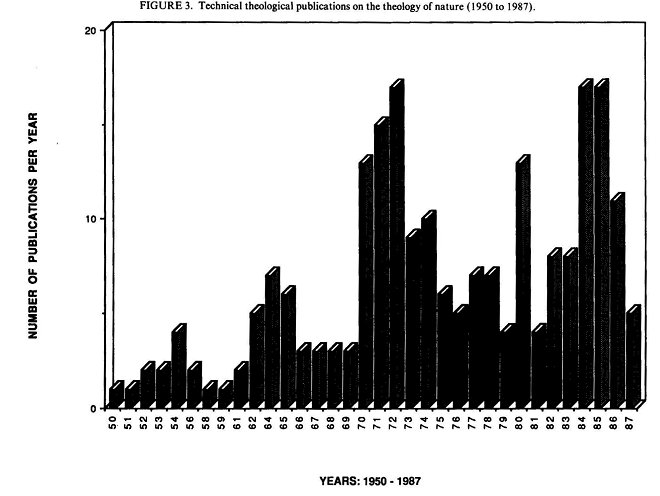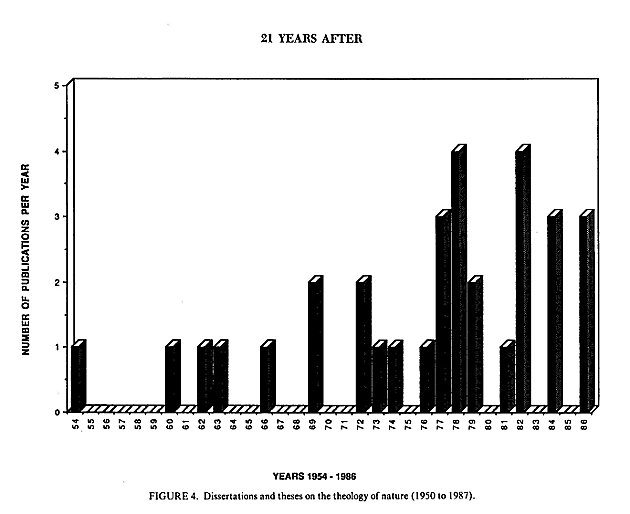 Science
in Christian Perspective
Science
in Christian Perspective Science
in Christian Perspective
Science
in Christian Perspective
Twenty-One Years After "The Historical Roots of Our Ecologic Crisis"
How Has the Church Responded?
JOSEPH K. SHELDON
Department of Biology Eastern College St. Davids, PA 10987
From: PSCF 41 (September 1989): 152-158.
A study of Christian literature of the 20th century discloses a growing concern for the Creation, reflected by a sharp increase in the number of theological papers on the Creation and man's role as God's image bearer. Christian ethicists have joined the discussion, and, at the popular level, the literature spans the gamut Of environmental concerns. The publication of "The Historical Roots of Our Ecologic Crisis" by Lynn White in 1967 implicated the Judeo-Christian tradition as the cause of the crisis. This accusation was a major factor responsible for the sudden increase in creation-related publications in the early 1970's.
The world is about to enter another revolution. According to Dick Wright in Biology Through the Eyes of Faith, (Harper & Row, 1989), we have passed through the Darwinian and Biomedical Revolutions, are enmeshed in the Genetic Revolution, and face the onrushing Environmental Revolution. Our response to the last will shape the course of the future. The Church must play a strategic role in the transition years. Its task is one of restoration. The burden for the redemption of Creation rests on the shoulders of the redeemed in Christ (Romans 8:19-22). It is the purpose of this paper to assess our progress. The material presented here is part of an extensive bibliographical study of the Christian community's response to the environmental crisis. Its scope was limited to works published in English.
Christian literature reflects a broad concern for environmental matters. Common themes include species extinctions and the loss of genetic diversity, the crisis of expanding human population, the impact of modern technology, the use of our natural resources, pollution, and the need to apply the "discipline of simplicity" to our lives. On the theological side, the Church has struggled to determine humanity's intended relationship with Creation.
Several events of the past twenty-six years stand as milestones. Twenty-six years ago, Rachel Carson's Silent Spring was published. For the first time, ordinary people began to view nature as vulnerable to the effects of technology. In 1965, the Faith-Man-Nature Group was formed to provide channels for basic scholarship and creative thought for building an explicit, sensitive Judeo-Christian approach to the environment. The group held several national conferences and published their proceedings. Twenty-two years ago, Lynn White, Jr. blamed the Church for the ecological crisis (White, 1967). Specifically, he felt that Scripture teaches a utilitarian and dominionistic attitude toward nature rather than a steadily one. On April 22, 1970 we celebrated our first Earth Day. In 1979 Vincent Rossi formed the eleventh Commandment Fellowship based on the "commandment" that "The earth is the Lord's and the fullness thereof: thou shalt not despoil the earth, nor destroy the life thereon." According to an article in the 13 May 1987 issue of the Christian Century, there are now chapters in more than 20 cities which are actively encouraging the development of a personal and public environmental ethic. In 1983, Constance Cumbey and David Hunt published books addressing the "New Age" movement (Cumbey, 1983 and Hunt, 1983). In their attempt to deal with this critical challenge to the Church they labeled many Christians who bad addressed environmental concerns as heretics, claiming that Scripture provides no justification for environmental involvement and that it places one in the camp of the New Age. In 1987, the North American Conference on Christianity and Ecology (NACCE) was convened to mobilize untapped strength in the local church for the task of creation redemption and restoration. In 1988, NACCE held several regional conferences.
Review of Literature Prior to 1967
Nine works were located with publication dates before 1950. Many early papers were anthropocentric in outlook, but several had clear statements of what we presently refer to as "environmental stewardship" concerns. Some important theological papers appeared during this time which contributed significantly to the birth of our presently emerging theology of nature. A gradual trend of awareness by Christians of environmental, scientific, and technological matters is apparent as the number of papers increases toward the end of the period (Figure 1).
One of the earliest significant works was by Bailey in 1915. This remarkable book, The Holy Earth, laid the groundwork for a loving, stewardly care of the Creation. Although utilitarian to a degree, protection was clearly urged. "We did not make the earth," wrote Bailey, "We have received it and its bounties. If it is beyond us, so it is divine. We have inescapable responsibilities. It is our privilege so to comprehend the use of the earth as to develop a spiritual stature. When the epoch of mere exploitation of the earth shall have worn itself out, we shall realize the heritage that remains and enter new realms of satisfaction" (Bailey, p. x). Bailey stated, "Merely to make the earth productive and to keep it clean and to bear a reverent regard for its products, is the special prerogative of a good agriculture and a good citizenry founded thereon; this may seem at the moment to be small and ineffective as against mad impersonal and limitless havoc, but it carries the final hearing; and while the land worker will bear much of the burden on his back he will also redeem the earth" (Bailey, p. 83).
The 1953 publication of Nature and Man in Biblical Thought by E.C. Rust, was the first of his several significant works dealing with the biblical basis of the man-nature relationship. A high view of nature is evident throughout.
Joseph Sittler has been a major contributor in the developing theology of nature. His works include A Theology for Earth (1954), Called to Unity (1962) and Nature and Grace (1964). In Nature and Grace, Sittler wrote:
Man is not flung into nature as if nature were a neutral storehouse for his biological needs and intelligible operations. Man is placed in nature; and this nature is given a good and holy evaluation. And therefore man's relation to nature is not merely neutral, rational, supportive, or esthetic. It is moral-and absolutely so. The Command of God is not that he should simply utilize the given, but that he should care for it. And the suggestion is more than faint that if he does not rightly care he shall neither rightly enjoy nor sanely use. (Sittler, 1964, p. 255).
W. D. Stacey, near the end of a paper titled Christian View of Nature, clearly defined the redemption of humanity as the key to the release of nature from the bondage of the Fall. He addressed Romans 8:9-22 and concluded by stating: "This brings us to the last point in the enquiry. Because the creation waits for 'the revealing of the sons of God,' the redemption of man will be the means of the redemption of Nature" (Stacey, 1956, p. 366).
G. H. Williams, in Wilderness and Paradise in Christian Thought, presented a clear discussion of humanity's role as steward of Creation. He stated that:
Truly the stewardship of Adam for all creatures in the Park of the Great King and the redemptive assignment laid upon Noah before the Deluge is literally in man's keeping today.... Wherever we live and work, we must have in our being or refresh within us the awareness of a real wilderness, which now we are called upon not only to contemplate periodically as did the desert Fathers, but also to conserve for ourselves and our posterity as well as in the interest of the myriad creaturely forms themselves. (Williams, 1962, pp. 136-137).
Others who also emphasized a stewardly care of the cosmos included Brattgard (1963) God's Stewards, Bring (1964) The Gospel and the New Creation, and Margaret Mead, in the introduction to White (1964) Christians in a Technological Era. Mead described this responsibility as a burden that is "perhaps even greater than that laid on humanity when our primal parents first ate of the fruit of the tree of knowledge of good and evil-the burden of responsibility for the survival of life on earth" (H. White, p. 11). Baer (1966) in Land Misuse: A Theological Concern, called for immediate action. He stated that:
If the church is to take the incarnation seriously, she can no longer evade the problems of man's relation to the land. She must learn to recognize the crucial issues and contribute her support to progressive and far-sighted policies. Hopefully, she will encourage the development of new technology. But the more immediate need is to help out in efforts to combat public apathy and to resist business and political interests that stand to profit from the status quo. (Baer, p. 1241)


The quotations above all have come from traditional Western Christianity. It is obvious that art environmental awareness was present and continues to be among some in the Church. However, a distinct theology of nature has yet to be formulated. This apparently is not the case in the Eastern Christian tradition where nature has not been so desacralized and remains a part of the theological framework. The following statement of man's responsibility for the nurture and redemption of the non-human Creation by Clement, a French Orthodox theologian, in 1958 has been cited as an example of the theological position of the Christian East:
If the spiritual destiny of man is inseparable from that of humanity as a whole, it is also inseparable from that the terrestrial cosmos. The sensible universe as a whole constitutes, in fact, a prolongation of our bodies. Or rather, what is our body, if it is not the form imprinted by our living soul on the universal 'dust' which unceasingly penetrates us. There is no discontinuity between the flesh of the world an human flesh; the universe participates in human nature as it constitutes the body of humanity.... Man is the personality of the cosmos, its conscious and personal self-expression, it is he who gives meaning to things and who has to transfigure them. (Rigdon, 1983, pp. 51-52)
1967 And "The Historical Roots"
The publication of "The Historical Roots of Our Ecologic Crisis" (White, 1967) was significant in raising the care of the Creation as an issue in the Church. In White's view, Western Christian theology is "the most anthropocentric religion the world has seen" (L. White, D. 1205). He believes that the Creation is portrayed in scripture only as a backdrop to serve human needs, and that Christianity has taught that "it is God's will that man exploit nature for his proper ends" (p. 1205). He goes on to say that: "Both our present science and our present technology are so tinctured with orthodox Christian arrogance toward nature that no solution for our ecologic crisis can be expected from them alone. Since the roots of our trouble are so largely religious, the remedy must also be essentially religious (p. 1207). Many in the Church felt that White's scriptural interpretations were in error. The result was two-fold: a re-examination of the Church's theology of nature, and a resounding denial that Scripture teaches a dominionistic, utilitarian attitude toward the Creation rather than one based on loving, nurturing care.
An increase in Christian literature addressing environmental concerns in general and Lynn White's charges in particular was noticeable by 1969 (Figure 1). Apparently, two to three years were required for Christians to realize, digest, and respond to White's charges. Numerous papers since 1969 have been direct responses to White's accusations. White's paper, perhaps more than any other single factor, was responsible for making the Creation and the need for its stewardly care an issue in the Christian press.
Post 1967 Publications
Figure I displays the number of publications by year on all subjects relating the Judeo-Christian tradition with the environment. The influence of Lynn White's paper is evident. Following a rush of papers in the early 1970's, the total number of publications rapidly dropped. Fluctuations were often due to a single thematic issue in a journal dealing with the environment. For example, the fall 1985 issue of Epiphany had 13 citations. During the past few years, an upward trend is again evident.
The distribution of non-technical papers-editorials and relatively short articles intended to prick the environmental conscience of lay Christians-is illustrated in Figure 2. Again, the impact of White in 1967 is evident. The number of publications declined rapidly following 1970 and then reached a plateau of 10 to 15 papers per year. This persisted until 1985 when another upturn began. Considering the large number of Christian journals today, the average reader has little exposure to such material, and most have probably never heard of a "theology of nature."
The status of the more technical theological literature is seen in Figure 3. Some significant publications appeared before 1970, but they were scattered and few in number. The publications peaked in the early 1970's and reached another high point in the mid-1980's.

The number of dissertations and theses related to the theology of nature (Figure 4) is low but increasing. Considering the number of seminaries and universities offering degrees in theology, it appears that the theology of nature is not a popular topic.

Although there has been much written on the theology of nature, the subject still remains ill defined. No synthesis has yet occurred and few contributors are aware of the voluminous literature waiting to be tapped. As Santmire pointed out:
There is, as yet, no comprehensive review of the contemporary discussion of the theology of nature, which emerged in many countries in the late 1960's and which now includes more than twenty-five book-length studies and hundreds of articles. This is symptomatic of the discussion itself, which has generally been fragmented and occasional. Books continue to appear which betray no awareness that an international discussion of the theology of nature has been underway for twenty years. (Santmire, 1985, p. 222)
Susan Bratton of the University of Georgia told the Christian College Coalition Conference on "Biology in the Christian College Classroom" in Spokane, Washington in June 1987 that "it is time to stop apologizing for our behavior and to get on with the task of being stewards." For this to occur, it is essential that a synthesis take place in the theological understanding of the position of nature and humanity's relationship to it.
The two papers by J.W. Klotz (1971, 1984), published in the Creation Research Society Quarterly, were important exceptions to the general lack of publications coming from the "young-earth" press which has focused most of its attention on the time and method of creation. R.E. Timm also recognized this when he stated that young-earth creationists "miss the theological messages of these rich Biblical creation materials" (Timm, 1986, p. 103). Cal DeWitt of Au Sable Institute makes the same point when he likens the Creation to a beautiful painting. While a group of art critics who are standing near the painting argue about details of the artist's technique in painting the masterpiece, people in another group are busy cutting the priceless work of art into strips, removing the paint, and selling the cloth for toilet paper. Klotz stated that "the consistent creationist is an environmentalist because he recognizes God as his Creator and the Creator of everything. He realizes, too, that he is but a steward with stewardship responsibilities.... The creationist seeks to preserve the good world over which God has made him steward" (Klotz, 1984, p. 8).
One of the most significant recent works is God in Creation: A New Theology of Creation and the Spirit of God by Jiirgen Moltmann (1985). Moltmann has emphasized God's immanence in Creation (the indwelling/sustaining Spirit) in contrast to His transcendent nature (God the Father). This cosmic indwelling of creation by the Creator forces a radical reinterpretation of man's "freedom" to exploit what previously had been seen as raw material to satisfy his wants.
The Future
Yes, we are moving ahead, but as Pogo has said, "I have met the enemy and he is us." Piecemeal problem solving is not the answer. The world is in need of a sustainable environmental ethic, and the Lord has placed the responsibility for its establishment in the bands of His Church. As the Church incorporates the care of Creation into its theological framework, critters become creatures, environment becomes Creation, and the "natural laws" of science are recognized as the invisible presence of the Spirit sustaining His Creation (Psalm 104:29-30).
The recent controversies raised by Constance Cumbey (1983) and David Hunt (1983) continues to be a concern. The New Age movement is a real threat to the Church and must be addressed. But Cumbey is incorrect to suggest that the Lord is not interested in His Creation and has not placed us in a position of authority for its care. The Creation belongs to the Lord, but its redemption rests in the hands of the Christian. Loren Wilkinson, who was on the receiving end of Cumbey and Hunt's accusations, provides an excellent review of the situation in Tending the Garden (Wilkinson, 1987).
A related concern to many in the Church who are working toward the healing of Creation is a branch of "New Age" referred to as "Creation Spirituality." With its strong emphasis on a nurturing, loving care Of Creation, Creation Spirituality continues to be quite attractive to quasi-religious individuals, including some Christians who are not well grounded in Scripture. Although heavy in biblical emphasis, much of its teaching draws on extrabiblical material, ranging from pantheism to evolutionary development of "man" and dreams of utopian societies where "man" finally becomes "Man."
Lynn White's assertion that the solution for our ecologic crisis cannot come from science and technology but must emerge from a religious swell of the people is most significant. Both the New Age in general and Creation Spirituality in particular are becoming a force in today's world, with environmental care a central theme of their theologies. Although the Church is beginning to awaken to its role of earthkeeping, it has produced few recognized leaders in the environmental field. Most see the Church as a latecomer that is still struggling to climb aboard the environmental wagon when, in reality, it should be the driver.
ACKNOWLEDGEMENTS
I wish to express my gratitude to ASA member Fred Van Dyke, Dave Wise (former student of Cal DeWitt), and to the Au Sable Institute of Environmental Studies for significant contributions to the bibliographical study.
REFERENCES
Baer, R.A., Jr. 1966. "Land Misuse: A Theological Concern." Christian Century, 12 Oct., pp. 1239-1241.
Bailey, L. H. 1915. The Holy Earth. Reprinted, in cooperation with the author, by The Christian Rural Fellowship, 1946.
Brattgard, H. 1963. God's Stewards: A Theological Study of the Principles and Practices of Stewardship. Gene J. Lund, trans. (Minneapolis: Augsburg Publishing House).
Bring, R. 1964. "The Gospel of the New Creation." Dialog 3:274-282.
Cumbey, C. 1983. The Hidden Dangers of the Rainbow: The New Age Movement and Our Coming Age of Barbarianism. (Shreveport, LA: Huntington House).
Hunt, D. 1W. Peace, Prosperity and the Coming Holocaust. (Eugene, OR: Harvest House). See comments concerning Cumbey 1983.
Klotz, J.W. 1971. "Creationism and our Ecological Crisis." Creation Research Society Quarterly 8:15, 49.
Klotz, J.W. 1984. "Creationist Environmental Ethic." Creation Research Research Quarterly 21:6-8.
Moltmann, H. 1985. God in Creation: A New Theology of Creation and the Spirit of God. (San Francisco: Harper & Row).
Rigdon, V.B. 1983. "Creation Within the Love of God." Journal of Presbyterian History 61:43-54.
Rust, E.C. 1953. Nature and Man in Biblical Thought. Vol. 40, Lutterworth Library. (London: Lutterworth Press).
Santmire, H.P. 1985. The Travail of Nature: The Ambiguous Ecological Promise Of Christian Theology (Philadelphia: Fortress Press).
Sittler, J. 1954. "A Theology for Earth." The Christian Scholar 37:367-374.
Sittler, J. 1962. "Called to Unity." The Ecumenical Review 14(2):177-187.
Sittler, J. 1964. "Nature and Grace: Reflections on an Old Rubric." Dialog 3:252-56.
Stacey, W. D. 1956. "Christian View of Nature." Expos. T. 67: 364-367.
Timm, R.E. 1986. "Let's Not Miss the Theology of the Creation Accounts." Currents in Theology and Mission 13(2):97-105.
White, H., ed. 1964. Christians in a Technological Era. (New York: Seabury Press).
White, L., Jr. 1967. "The Historical Roots of Our Ecologic Crisis." Science 155:1203-1207.
Wilkinson, L. 1987. "New Age, New Consciousness, and the New Creation," in Wesley Granberg-Michaelson, Tending the Garden: Essays on the Gospel and the Earth. (Grand Rapids; Eerdmans).
Williams, G.H. 1962. Wilderness and Paradise in Christian Thought.. The Biblical Experience of the Desert in the History of Christianity & the Paradise Theme in the Theological Idea of the University. (New York: Harper & Row).
Wright, Richard T. 1989. Biology Through the Eyes of Faith. (New York: Harper & Row).
Joseph K. Sheldon received a B.S. in Biology from The College of Idaho and a Ph.D. in Entomology from the University of Illinois in 1972. He has taught eighteen years for Eastern College and is on the summer faculty at Au Sable Institute of Environmental Studies. He currently serves as a member of ASA's Commission on Global Resources & Environment, and is a Fellow of the ASA. He is also Vice President of the American Entomological Society. His research interests and primary area of writing include ecology, and biblical and scientific perspectives of the environmental crisis.